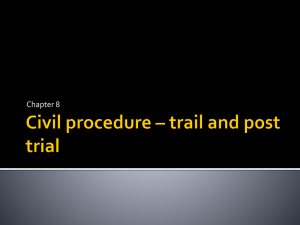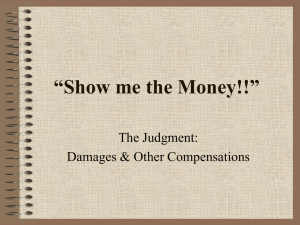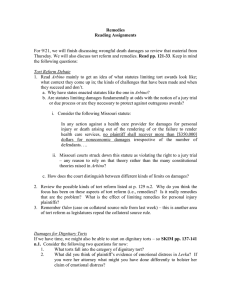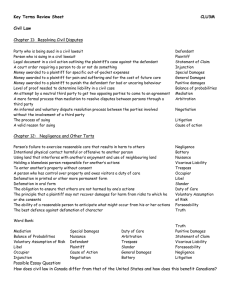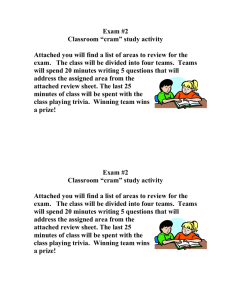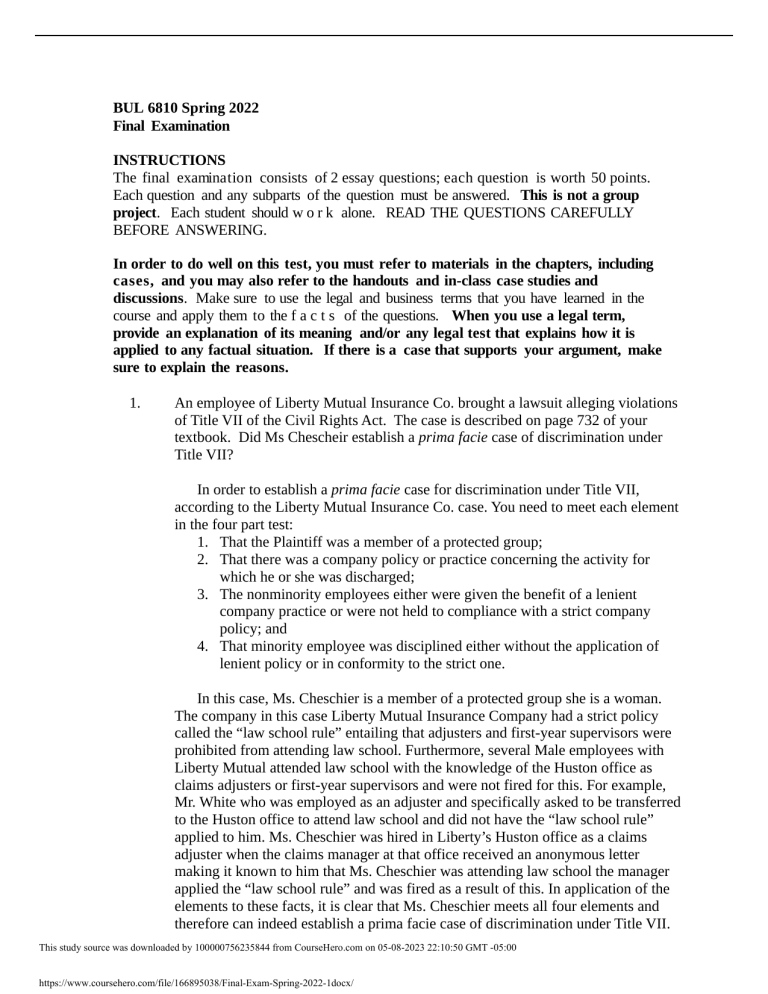
BUL 6810 Spring 2022 Final Examination INSTRUCTIONS The final examination consists of 2 essay questions; each question is worth 50 points. Each question and any subparts of the question must be answered. This is not a group project. Each student should w o r k alone. READ THE QUESTIONS CAREFULLY BEFORE ANSWERING. In order to do well on this test, you must refer to materials in the chapters, including cases, and you may also refer to the handouts and in-class case studies and discussions. Make sure to use the legal and business terms that you have learned in the course and apply them to the f a c t s of the questions. When you use a legal term, provide an explanation of its meaning and/or any legal test that explains how it is applied to any factual situation. If there is a case that supports your argument, make sure to explain the reasons. 1. An employee of Liberty Mutual Insurance Co. brought a lawsuit alleging violations of Title VII of the Civil Rights Act. The case is described on page 732 of your textbook. Did Ms Chescheir establish a prima facie case of discrimination under Title VII? In order to establish a prima facie case for discrimination under Title VII, according to the Liberty Mutual Insurance Co. case. You need to meet each element in the four part test: 1. That the Plaintiff was a member of a protected group; 2. That there was a company policy or practice concerning the activity for which he or she was discharged; 3. The nonminority employees either were given the benefit of a lenient company practice or were not held to compliance with a strict company policy; and 4. That minority employee was disciplined either without the application of lenient policy or in conformity to the strict one. In this case, Ms. Cheschier is a member of a protected group she is a woman. The company in this case Liberty Mutual Insurance Company had a strict policy called the “law school rule” entailing that adjusters and first-year supervisors were prohibited from attending law school. Furthermore, several Male employees with Liberty Mutual attended law school with the knowledge of the Huston office as claims adjusters or first-year supervisors and were not fired for this. For example, Mr. White who was employed as an adjuster and specifically asked to be transferred to the Huston office to attend law school and did not have the “law school rule” applied to him. Ms. Cheschier was hired in Liberty’s Huston office as a claims adjuster when the claims manager at that office received an anonymous letter making it known to him that Ms. Cheschier was attending law school the manager applied the “law school rule” and was fired as a result of this. In application of the elements to these facts, it is clear that Ms. Cheschier meets all four elements and therefore can indeed establish a prima facie case of discrimination under Title VII. This study source was downloaded by 100000756235844 from CourseHero.com on 05-08-2023 22:10:50 GMT -05:00 https://www.coursehero.com/file/166895038/Final-Exam-Spring-2022-1docx/ Jennings, Marianne. Business Its Legal, Ethical, and Global Environment. 11th ed., Cengage, 2022. 2. You are the CEO of a small hospital located in a southeastern state. You have successfully competed with larger hospitals in the area because your hospital is more efficient than the larger hospitals, and you have a dedicated staff of doctors who have remained loyal to you despite receiving lower pay than doctors at the large hospitals. Your hospital serves a rural population of mostly lower middle-class farm families who work small tracts of land. Most of those small farms have been passed down from generation to generation. In addition, your hospital serves a large population of immigrant families who work as farm hands on the local farms. Most of these families live at or below the poverty level. Yours is the only hospital within 50 miles. Recent news reports have caused you great concern. Several of the large hospitals have been successfully sued by patients who claimed they were injured as the result of medical malpractice. At least six hospitals have paid out multi-million-dollar damage claims, some of which included punitive damages. You realize that even one such lawsuit would likely put your hospital out of business. At a recent conference of small rural hospitals that you attended, several CEO’s warned that ours had become a very litigious society and that small hospitals need to protect themselves from these frivolous lawsuits. One speaker suggested that the tort laws should be changed to prevent these huge damage awards. The more you listened, the more you realized that these kinds of lawsuits could destroy your business, leaving many patients without hospital service. The last speaker at the conference was a lobbyist hired by the hospital industry to try to convince the state legislature to pass, among other things, a law placing a cap on damage awards for medical malpractice. He invited all interested hospital CEO’s to join in the effort to reform the tort law. One of the members of the Board of Directors of your hospital also attended the conference. She has reported back to the full Board. As a result, the Board has voted to support the idea of tort reform. The Board has directed you to present, at the next meeting of the Board, a plan for tort reform in your state. Describe, in detail, the plan for tort reform that you will present at the next Board meeting. In determining the plan for tort reform, based on the recent medical malpractice cases in our area. We must first analyze what a “tort” is they are wrongful actions that lead to legal liability by the Defendant. In analyzing what placing a cap on damages entails, damages are the award that one receives for what the judge or jury believes you deserve for the damage you suffered, there are two types of damages in a tort action. Compensatory which means the amount required to place a party in as good position before the breach. The second is Punitive, which are damages intended to punish the Defendant. Placing a cap on them means that the damages received by the plaintiff for a This study source was downloaded by 100000756235844 GMT tort cause of action wouldfrom beCourseHero.com limited to on a 05-08-2023 certain 22:10:50 amount or-05:00 to one specific type of damage. https://www.coursehero.com/file/166895038/Final-Exam-Spring-2022-1docx/ Furthermore, we must first take into consideration the ethical issues that come with placing a cap on damages. Placing a cap on damages can be a double-edged sword, there are benefits for the defendant as it limits the amount of damages that they have to pay the plaintiff. However, this also means that it limits the amount of damages awarded to the plaintiff no matter how severe or egregious the case or injury is. The other thing that we must take into consideration is the Due Process Clause, which limits the courts and legislatures’ discretion to limit the damages that can be awarded to a Plaintiff. Taking that into consideration the reform that we need is one that does not overly exert the amount of damages nor one that limits them too low for the Plaintiff’s actual harm. The amount of damages awarded to the Plaintiff should be based on the actual damages caused by the medical malpractice. Medical malpractice cases should be limited to just compensatory damages as their purpose is to set the Plaintiff back to their original position before the injury. There is an argument to be made that by limiting the damages to just compensatory and eliminating punitive damages that the Defendant will not “learn their lesson” and will likely lead to the same kind of injury again. This would not be true because a medical malpractice case on its own gives the Defendant a bad reputation and they also have to pay damages to the plaintiff making it so that the Defendant is less likely to commit such tort again as there is a risk of losing their license in addition to this. Furthermore, not placing a cap on damages places small businesses in a vulnerable position. If there is no limit to the amount of damages that a Defendant has to pay the Plaintiff then it may occur that the Plaintiff may abuse this and claim more damages than the Defendant could possibly pay. This also is hurtful for the Plaintiff because then they may not receive the award that they deserve because the Defendant cannot pay that amount. In keeping our Hospitals to work properly for the citizens in our surrounding area we must take tort reform into consideration. The only way to get reform to pass is on a state by state basis where congressmen get to interpret the law, whatever position you have on tort reform the only way to execute these ideas would be to vote into power representatives that think similarly to ones self. Jennings, Marianne. Business Its Legal, Ethical, and Global Environment. 11th ed., Cengage, 2022. This study source was downloaded by 100000756235844 from CourseHero.com on 05-08-2023 22:10:50 GMT -05:00 https://www.coursehero.com/file/166895038/Final-Exam-Spring-2022-1docx/ Powered by TCPDF (www.tcpdf.org)

